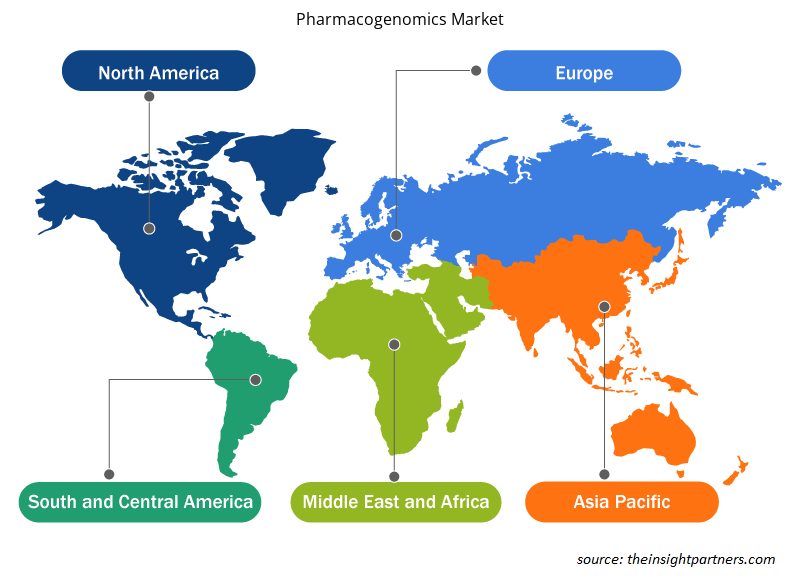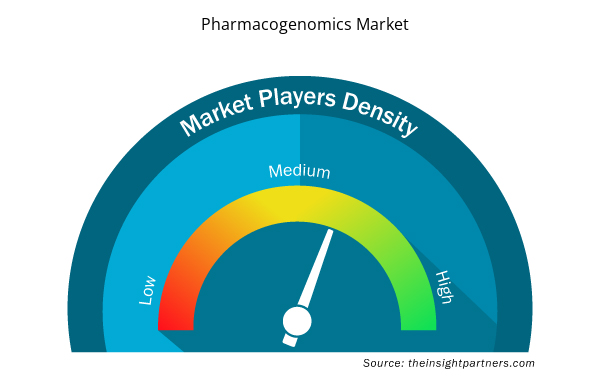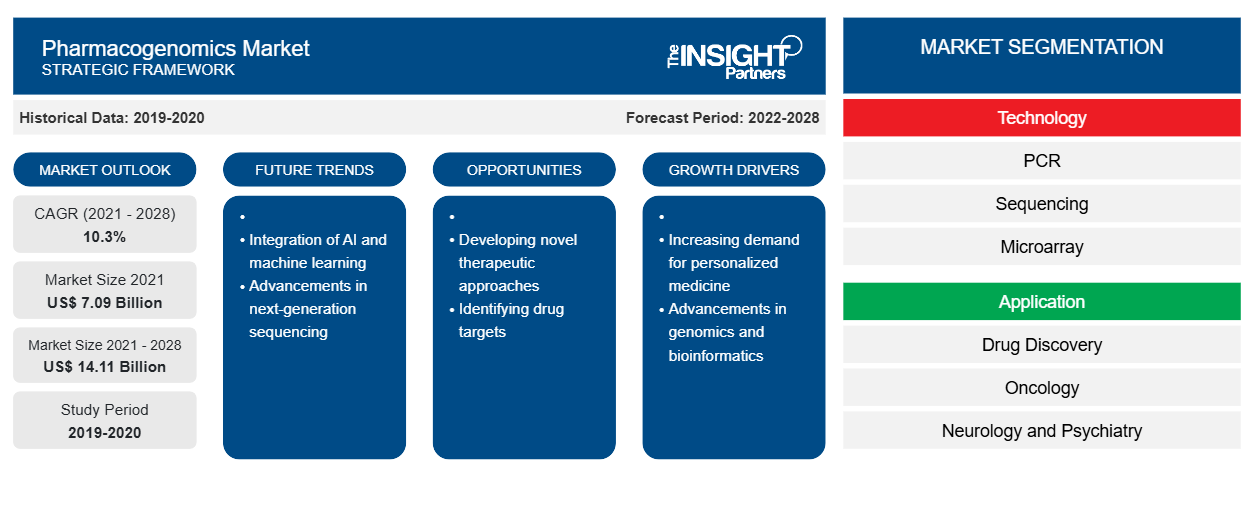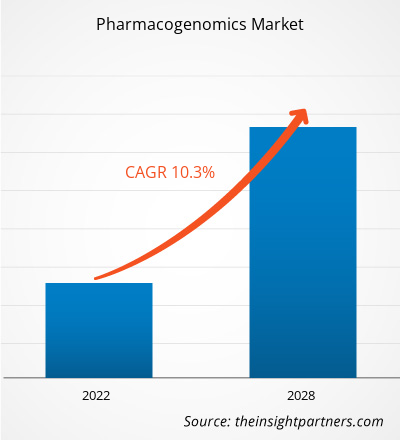药物基因组学市场规模预计将从 2021 年的 70.8781 亿美元增至 2028 年的 141.078 亿美元;预计 2021 年至 2028 年的复合年增长率为 10.3%。
慢性病患病率不断上升是推动市场增长的最关键因素之一。许多老年人 (>60%) 患有两种或两种以上的慢性病。双胞胎研究表明,基因会导致慢性病,如心血管疾病 (CVD)、糖尿病、肥胖症、类风湿性关节炎、阿尔茨海默病 (AD) 和抑郁症。利用全基因组关联研究 (GWAS) 的分子遗传数据,现在可以测量这些慢性病的个体风险。根据美国疾病控制和预防中心 (CDC) 的数据,2020 年,美国近 60% 的人患有至少一种慢性病,40% 的人患有两种或两种以上的慢性病。 慢性病发病率的不断上升引发了对药物基因组学技术开发新疗法的需求。
定制此报告以满足您的需求
您可以免费定制任何报告,包括本报告的部分内容、国家级分析、Excel 数据包,以及为初创企业和大学提供优惠和折扣
- 获取此报告的关键市场趋势。这个免费样品将包括数据分析,从市场趋势到估计和预测。
2021-2028 年,北美很可能主导药物基因组学市场。美国在北美占有最大的市场份额,预计在预测期内将继续保持这一趋势。由于开发治疗癌症的精准医疗的研究活动不断增加、领先的生物制药和制药公司的存在不断增加以及该国药物基因组学研究的不断增长,预计未来几年美国的药物基因组学市场将增长。基于药物基因组学的癌症治疗的采用率不断上升,领先的市场参与者正在推出与这种方法相关的几种新产品。此外,监管机构的支持预计将在预测期内推动美国市场的发展。目前,有几项临床试验正在研究药物基因组学技术,以开发精准药物并提高治疗的总体反应率。 2021年5月,美国食品药物管理局(FDA)批准Lumakras(Sotorasib)用于针对肿瘤表达KRAS基因G12C突变的非小细胞肺癌患者的靶向治疗。
市场洞察
药物基因组学研究资金不断增加推动市场增长
基因组测序在临床实践中的应用越来越广泛,未来五年内,预计医疗体系将产生来自 6000 多万患者的基因组数据。药物基因组学正在迅速转向临床实践,至少有 14 个国家的政府投资支持将药物基因组学应用于医疗体系,总额超过 40 亿美元。
英国宣布启动全球最大的基因组项目,这是慈善机构和制药公司之间价值 2 亿欧元的公私合作项目的一部分。英国已经通过英国创新署牵头的 10 万个基因组项目开发了世界上最大的基因组数据库,该项目是英国研究与创新的一部分。该项目将资助研究人员和行业将英国医疗服务的数据和现实证据结合起来,创造能够有效诊断疾病的新产品和服务。
此外,2018 年 8 月,总部位于马萨诸塞州的波士顿科学公司宣布获得 430 万美元的种子资金,并与 Veritas Genetics 合作。这些资金将支持该公司的使命,即通过创建一个值得信赖、安全且分散的基因组数据市场,进入个人基因组测序时代。
基于技术的见解
根据技术,药物基因组学市场细分为 PCR、测序、微阵列、凝胶电泳、质谱等。PCR 细分市场进一步细分为标准 PCR、实时 PCR 和数字 PCR。预计 PCR 细分市场将在 2021-2028 年期间占据药物基因组学市场的最大份额。聚合酶链反应 (PCR)是一种常用技术,可快速生成数百万至数十亿份特定 DNA 样本的副本,使科学家能够取少量 DNA 样本并将其扩增到足够多的量以进行详细研究。PCR 技术在基因克隆和操作、DNA 克隆、基因诱变、基因功能分析、病原体检测和耐药性测定中起着关键作用。各种制药和生物制药公司都为药物基因组学和药物开发应用提供 PCR 解决方案。例如,赛默飞世尔科技公司为药物基因组学应用提供实时 PCR 解决方案。
基于应用程序的见解
根据应用,药物基因组学市场细分为药物发现、肿瘤学、神经病学和精神病学、疼痛管理、心血管疾病等。肿瘤学领域占有相当大的市场份额,预计在预测期内将继续占据主导地位。癌症药物基因组学为当前的癌症治疗贡献了几项重要发现,改变了治疗决策的范式。世界卫生组织 (WHO) 表示,2020 年癌症导致约 1000 万人死亡。此外,根据美国癌症协会的数据,到 2040 年,全球癌症负担预计将上升至 2750 万新病例和 1630 万癌症死亡病例。如此高的数字表明,癌症发病率的上升正在产生对原始诊断和预防性治疗的需求。有许多方法可以诊断癌症,例如 PCR、INAAT 和 NGS。PCR(聚合酶链反应)的概念导致了临床 DNA 检测的巨大进步。基于 PCR 的方法需要简单的仪器和基础设施,仅利用微量的生物材料,并且与临床常规非常协调。由于化疗药物的治疗指数逐渐减小,并且存在危及生命的不良反应风险,药物基因组学在肿瘤学中的应用意义重大。
基于最终用户的洞察
根据最终用户,药物基因组学市场细分为医院和诊所、生物制药公司、合同研究组织 (CRO) 和合同制造生产组织 (CDMO) 等。合同研究组织 (CRO) 和合同制造生产组织 (CDMO) 占有相当大的市场份额,预计在预测期内将继续占据主导地位。合同研究组织 (CRO) 通过对其开发的产品和技术进行临床试验来帮助各种公司和组织,而合同开发和制造组织 (CDMO) 则协助公司开发和制造产品。CRO提供的服务包括项目管理、数据库设计和构建、数据输入和验证、临床试验数据管理、药品和疾病编码、质量和指标报告、统计分析计划和报告、验证编程、安全性和有效性摘要以及最终研究报告。CRO还提供一些其他服务,如基因服务、克隆服务和表达。
在药物基因组学市场运营的公司采用无机增长战略来满足全球不断变化的客户需求,其中包括收购、合并以及与全球市场上的本地和国际参与者的合作。
药物基因组学市场区域洞察
Insight Partners 的分析师已详细解释了预测期内影响药物基因组学市场的区域趋势和因素。本节还讨论了北美、欧洲、亚太地区、中东和非洲以及南美和中美洲的药物基因组学市场细分和地理位置。

- 获取药物基因组学市场的区域特定数据
药物基因组学市场报告范围
| 报告属性 | 细节 |
|---|---|
| 2021 年市场规模 | 70.9 亿美元 |
| 2028 年市场规模 | 141.1亿美元 |
| 全球复合年增长率(2021 - 2028) | 10.3% |
| 史料 | 2019-2020 |
| 预测期 | 2022-2028 |
| 涵盖的领域 | 按技术分类
|
| 覆盖地区和国家 | 北美
|
| 市场领导者和主要公司简介 |
|
药物基因组学市场参与者密度:了解其对业务动态的影响
药物基因组学市场正在快速增长,这得益于终端用户需求的不断增长,而这些需求又源于消费者偏好的不断变化、技术进步以及对产品优势的认识不断提高等因素。随着需求的增加,企业正在扩大其产品范围,进行创新以满足消费者的需求,并利用新兴趋势,从而进一步推动市场增长。
市场参与者密度是指在特定市场或行业内运营的企业或公司的分布情况。它表明在给定市场空间中,相对于其规模或总市场价值,有多少竞争对手(市场参与者)存在。
在药物基因组学市场运营的主要公司有:
- F.霍夫曼-拉罗氏有限公司
- 雅培
- 牛津纳米孔技术公司
- 赛默飞世尔科技公司
- Illumina 公司
免责声明:上面列出的公司没有按照任何特定顺序排列。

- 了解药物基因组学市场的主要参与者概况
药物基因组学市场——细分
- 根据技术,药物基因组学市场细分为 PCR、测序、微阵列、凝胶电泳、质谱等。PCR 细分市场进一步细分为标准 PCR、实时 PCR 和数字 PCR。
- 根据应用,药物基因组学市场分为药物发现、肿瘤学、神经病学和精神病学、疼痛管理、心血管疾病等。
- 根据最终用户,药物基因组学市场细分为医院和诊所、生物制药公司、CRO 和 CDMO 等。
- 根据地域划分,皮内注射市场分为北美(美国、加拿大和墨西哥)、欧洲(法国、德国、意大利、英国、西班牙和欧洲其他地区)、亚太地区(澳大利亚、中国、印度、日本、韩国和亚太地区其他地区)、中东和非洲(沙特阿拉伯、南非、阿联酋和 MEA 其他地区)以及南美洲和中美洲(巴西、阿根廷和 SCAM 其他地区)。
F. Hoffmann-la Roche Ltd;Abbott;Oxford Nanopore Technologies;Thermo Fisher Scientific Inc;Illumina, Inc;QIAGEN;Agilent Technologies, Inc;Myriad Genetics, Inc;Admera Health;和 Dynamic DNA Laboratories 是少数在药物基因组学市场运营的公司。
- 历史分析(2 年)、基准年、预测(7 年)及复合年增长率
- PEST 和 SWOT 分析
- 市场规模价值/数量 - 全球、区域、国家
- 行业和竞争格局
- Excel 数据集



Report Coverage
Revenue forecast, Company Analysis, Industry landscape, Growth factors, and Trends

Segment Covered
This text is related
to segments covered.

Regional Scope
North America, Europe, Asia Pacific, Middle East & Africa, South & Central America

Country Scope
This text is related
to country scope.
常见问题
The global pharmacogenomics market based on technology is segmented into sequencing, PCR, gel electrophoresis, mass spectrometry, microarray, and others. In 2021, the PCR segment held the largest share of the market by technology and it is expected to witness fastest CAGR during 2021 to 2028, due to increasing utilization of this technology at global level.
The global pharmacogenomics market is segmented into North America, Europe, Asia Pacific, Middle East & Africa, and South & Central America. The North American area holds the largest market for pharmacogenomics. The United States held the most significant pharmacogenomics market and is expected to grow due to factors such as the increasing prevalence of chronic diseases and growing investments while the technological advancements by key players in pharmacogenomics is also boosting the growth rate in US.
The Asia Pacific region is expected to account for the fastest growth in the pharmacogenomics market. In Japan, India and South Korea, the market is expected to grow owing to the rapid development of research organizations and biopharmaceutical companies.
Several factors are believed to affect pharmacogenomics market in the coming years. Factors such as growing adoption of personalized therapies, increasing prevalence of chronic diseases, and growing funding in this sector are driving the market growth. However, lack of skilled professionals is likely to hamper the growth of the market.
The pharmacogenomics market majorly consists of the players such as F. Hoffmann-la Roche Ltd; Abbott; Oxford Nanopore Technologies; Thermo Fisher Scientific Inc.; Illumina, Inc.; QIAGEN; Agilent Technologies, Inc.; Myriad Genetics, Inc.; Admera Health; Dynamic DNA Laboratories among others..
Pharmacogenomics is a branch of science, which studies the role of gene over the activity of a drugs and hence helps the refreshers in predicting the response of novel as well as previously available therapies. Pharmacogenomics has direct application in the development of personalized medicine by testing single or multiple genes that are related to the disease. The main aim of this technology is to reduce the occurrence of treatment related adverse events and reduction in overall cost of treatment. The growing cases of ADRs and increasing demand of personalized therapies are expected to trigger the growth rate of this segment.
Trends and growth analysis reports related to Life Sciences : READ MORE..
The List of Companies - Pharmacogenomics Market
- F. Hoffmann-la Roche Ltd
- Abbott
- Oxford Nanopore Technologies
- Thermo Fisher Scientific Inc.
- Illumina, Inc.
- QIAGEN
- Agilent Technologies, Inc.
- Myriad Genetics, Inc.
- Admera Health
- Dynamic DNA Laboratories
The Insight Partners performs research in 4 major stages: Data Collection & Secondary Research, Primary Research, Data Analysis and Data Triangulation & Final Review.
- Data Collection and Secondary Research:
As a market research and consulting firm operating from a decade, we have published and advised several client across the globe. First step for any study will start with an assessment of currently available data and insights from existing reports. Further, historical and current market information is collected from Investor Presentations, Annual Reports, SEC Filings, etc., and other information related to company’s performance and market positioning are gathered from Paid Databases (Factiva, Hoovers, and Reuters) and various other publications available in public domain.
Several associations trade associates, technical forums, institutes, societies and organization are accessed to gain technical as well as market related insights through their publications such as research papers, blogs and press releases related to the studies are referred to get cues about the market. Further, white papers, journals, magazines, and other news articles published in last 3 years are scrutinized and analyzed to understand the current market trends.
- Primary Research:
The primarily interview analysis comprise of data obtained from industry participants interview and answers to survey questions gathered by in-house primary team.
For primary research, interviews are conducted with industry experts/CEOs/Marketing Managers/VPs/Subject Matter Experts from both demand and supply side to get a 360-degree view of the market. The primary team conducts several interviews based on the complexity of the markets to understand the various market trends and dynamics which makes research more credible and precise.
A typical research interview fulfils the following functions:
- Provides first-hand information on the market size, market trends, growth trends, competitive landscape, and outlook
- Validates and strengthens in-house secondary research findings
- Develops the analysis team’s expertise and market understanding
Primary research involves email interactions and telephone interviews for each market, category, segment, and sub-segment across geographies. The participants who typically take part in such a process include, but are not limited to:
- Industry participants: VPs, business development managers, market intelligence managers and national sales managers
- Outside experts: Valuation experts, research analysts and key opinion leaders specializing in the electronics and semiconductor industry.
Below is the breakup of our primary respondents by company, designation, and region:

Once we receive the confirmation from primary research sources or primary respondents, we finalize the base year market estimation and forecast the data as per the macroeconomic and microeconomic factors assessed during data collection.
- Data Analysis:
Once data is validated through both secondary as well as primary respondents, we finalize the market estimations by hypothesis formulation and factor analysis at regional and country level.
- Macro-Economic Factor Analysis:
We analyse macroeconomic indicators such the gross domestic product (GDP), increase in the demand for goods and services across industries, technological advancement, regional economic growth, governmental policies, the influence of COVID-19, PEST analysis, and other aspects. This analysis aids in setting benchmarks for various nations/regions and approximating market splits. Additionally, the general trend of the aforementioned components aid in determining the market's development possibilities.
- Country Level Data:
Various factors that are especially aligned to the country are taken into account to determine the market size for a certain area and country, including the presence of vendors, such as headquarters and offices, the country's GDP, demand patterns, and industry growth. To comprehend the market dynamics for the nation, a number of growth variables, inhibitors, application areas, and current market trends are researched. The aforementioned elements aid in determining the country's overall market's growth potential.
- Company Profile:
The “Table of Contents” is formulated by listing and analyzing more than 25 - 30 companies operating in the market ecosystem across geographies. However, we profile only 10 companies as a standard practice in our syndicate reports. These 10 companies comprise leading, emerging, and regional players. Nonetheless, our analysis is not restricted to the 10 listed companies, we also analyze other companies present in the market to develop a holistic view and understand the prevailing trends. The “Company Profiles” section in the report covers key facts, business description, products & services, financial information, SWOT analysis, and key developments. The financial information presented is extracted from the annual reports and official documents of the publicly listed companies. Upon collecting the information for the sections of respective companies, we verify them via various primary sources and then compile the data in respective company profiles. The company level information helps us in deriving the base number as well as in forecasting the market size.
- Developing Base Number:
Aggregation of sales statistics (2020-2022) and macro-economic factor, and other secondary and primary research insights are utilized to arrive at base number and related market shares for 2022. The data gaps are identified in this step and relevant market data is analyzed, collected from paid primary interviews or databases. On finalizing the base year market size, forecasts are developed on the basis of macro-economic, industry and market growth factors and company level analysis.
- Data Triangulation and Final Review:
The market findings and base year market size calculations are validated from supply as well as demand side. Demand side validations are based on macro-economic factor analysis and benchmarks for respective regions and countries. In case of supply side validations, revenues of major companies are estimated (in case not available) based on industry benchmark, approximate number of employees, product portfolio, and primary interviews revenues are gathered. Further revenue from target product/service segment is assessed to avoid overshooting of market statistics. In case of heavy deviations between supply and demand side values, all thes steps are repeated to achieve synchronization.
We follow an iterative model, wherein we share our research findings with Subject Matter Experts (SME’s) and Key Opinion Leaders (KOLs) until consensus view of the market is not formulated – this model negates any drastic deviation in the opinions of experts. Only validated and universally acceptable research findings are quoted in our reports.
We have important check points that we use to validate our research findings – which we call – data triangulation, where we validate the information, we generate from secondary sources with primary interviews and then we re-validate with our internal data bases and Subject matter experts. This comprehensive model enables us to deliver high quality, reliable data in shortest possible time.


 获取此报告的免费样本
获取此报告的免费样本